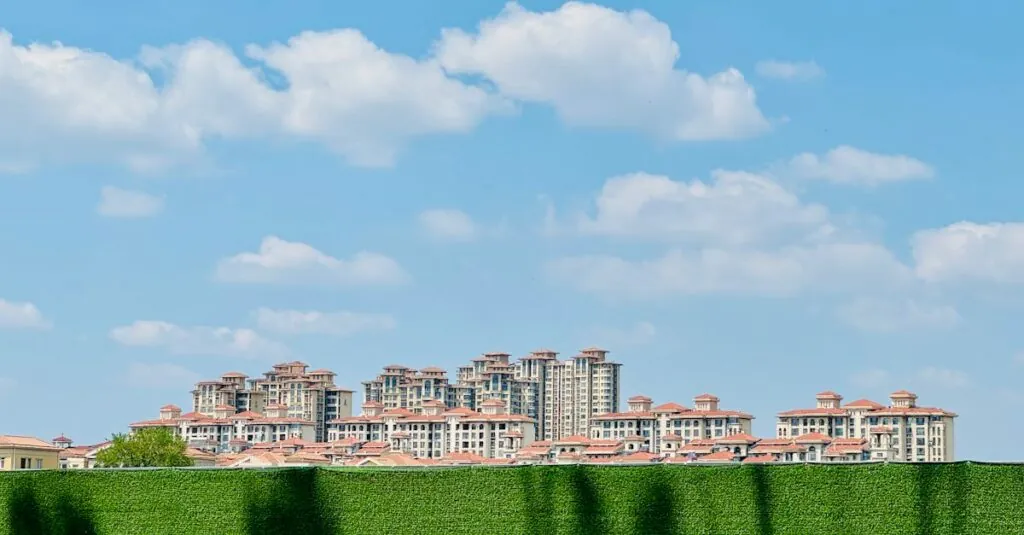Table of Contents
ToggleSydney’s real estate market isn’t just a place for beach lovers and coffee enthusiasts; it’s a goldmine for savvy investors. With its stunning views and vibrant culture, investing in property here can feel like finding a treasure chest buried under the sand. But don’t let the allure of the Harbour Bridge distract you from the numbers—this city’s investment potential is as solid as its iconic skyline.
Overview of Investment Property in Sydney
Sydney’s real estate market serves as a significant draw for investors, demonstrating consistent growth patterns. High demand characterizes the area, reflecting its prosperous economy and strong rental yields. Competitive pricing emerges in various suburbs, allowing investors to explore a range of opportunities.
Residential properties range from apartments to houses, each offering unique advantages. Apartment living appeals to young professionals, while family homes attract diverse demographics. Suburbs like Bondi, Parramatta, and Liverpool highlight diverse investment strategies, making them strategic choices.
Over the past decade, property values in Sydney soared, exhibiting an average growth rate of 5.5% annually. With an estimated population growth of 1.3 million people expected by 2036, housing demand will likely strengthen. Investors focusing on long-term appreciation should prioritize locations with ongoing urban development and infrastructure upgrades.
Rental demand remains robust in Sydney, with a rental yield of around 3.5% to 4.5%. Areas with good transport links or proximity to major employers often command higher rental prices. Potential investors should assess the local rental market, recognizing which suburbs drive demand most effectively.
Investing in Sydney requires careful consideration of various factors, including market trends, location desirability, and property management. Knowledgeable investors often utilize market analytics and local insights to make informed decisions. They typically engage with real estate experts to navigate the complexities of the market, ensuring their investments align with long-term goals.
Factors Influencing Investment Property Prices
Multiple elements impact investment property prices in Sydney, influencing both demand and value. Understanding these factors helps investors make informed decisions.
Location and Accessibility
Location plays a pivotal role in determining property prices. Proximity to the central business district or major transport hubs often leads to higher property values. Properties situated in suburbs with efficient public transport links attract more tenants, boosting rental yields. Areas like Bondi and Parramatta, known for their accessibility, typically command premium prices. Notably, investors should prioritize locations expected to benefit from future infrastructure developments. Higher population density in certain regions correlates with increased property demand, driving prices upwards consistently.
Amenities and Infrastructure
The availability of amenities significantly influences property values. Areas with quality schools, shopping centers, parks, and recreational facilities attract families and professionals alike. Accessibility to essential services enhances desirability, impacting rental income levels. Suburbs with advanced infrastructure, such as hospitals and entertainment venues, provide added value. Investing in regions with planned amenities is wise, as future developments can escalate property prices. Tailoring investment strategies to consider local amenities supports achieving higher returns on investment.
Types of Investment Properties in Sydney
Investors should consider various types of properties in Sydney, each offering unique benefits. Understanding these types helps in making informed investment decisions.
Residential Properties
Residential properties include apartments and houses that cater to a range of demographics. Investors find opportunities across multiple suburbs like Bondi, Parramatta, and Liverpool. Bonds yield rental returns between 3.5% and 4.5%. Growth rates show an average increase of 5.5% annually over the last decade. Properties near transport links attract higher demand. Young professionals often seek apartments near the central business district, aiming for convenience. Families frequently favor larger homes with access to quality schools and parks. This diverse market allows investors to tailor their strategies according to their goals.
Commercial Properties
Commercial properties encompass retail spaces, office buildings, and industrial units. Investors observe strong demand in high-traffic areas. Prices tend to correlate with proximity to major transport hubs, boosting rental yields. Supermarkets and retail chains seek locations near busy intersections. Office spaces benefit from good accessibility, appealing to businesses that prioritize convenience. Industrial properties near ports or main roads enhance logistical efficiency, attracting firms looking for warehouses and distribution centers. As urban areas develop, commercial properties are expected to see continued growth and stable returns.
Benefits of Investing in Sydney Real Estate
Investing in Sydney real estate offers numerous advantages. The city’s consistently strong demand and attractive rental yields draw investors seeking profitable opportunities.
High Demand and Rental Yields
High demand for rental properties creates a competitive market in Sydney. Rental yields often reach between 3.5% to 4.5%, particularly in well-connected neighborhoods. Suburbs like Bondi and Parramatta attract numerous tenants due to their amenities and transport links. Investors benefit from continuous demand as population growth forecasts indicate an additional 1.3 million residents by 2036. Strong rental yields paired with growing tenant numbers enhance the potential for steady income streams.
Capital Growth Potential
Capital growth potential remains robust within the Sydney real estate market. Over the past decade, property values have seen an average annual growth rate of 5.5%. Favorable economic conditions, combined with infrastructure developments, contribute to rising property prices. Areas with access to major transport hubs tend to experience accelerated growth. Prime investment locations, like Liverpool, show a resilient trajectory, making them attractive to investors looking for long-term financial gains. Investing in Sydney real estate positions individuals to capitalize on these upward trends effectively.
Challenges of Investment Property in Sydney
Investing in Sydney’s property market presents various challenges that potential investors must consider.
Market Volatility
Market volatility poses significant risks for investors in Sydney. Fluctuations in property values can occur due to economic changes, policy adjustments, or shifts in buyer demand. Investors often notice that areas with high demand, like Bondi and Parramatta, still experience occasional downturns. Property values in suburban regions may rise or fall, impacting overall profitability. A historical average annual growth of 5.5% indicates strong performance, but unpredictable shifts can disrupt forecasts. Understanding these dynamics helps investors navigate market uncertainties effectively.
Regulatory Concerns
Regulatory concerns significantly impact investment property decisions in Sydney. Investors face various laws concerning rental practices, tenant rights, and property modifications. Stricter regulations may emerge to enhance housing affordability or to address local issues. Changes in government policies can influence property taxes or stamp duty, affecting overall profitability. Staying informed about these regulations is crucial for investors aiming to comply and maximize returns. Collaborative discussions with real estate professionals can provide clarity on navigating these regulatory landscapes.
Investing in Sydney’s real estate market offers significant opportunities for those looking to build wealth. With strong rental yields and consistent property value growth the city remains an attractive option. Investors should focus on prime locations with excellent transport links and amenities to maximize returns.
While challenges like market volatility and regulatory changes exist staying informed can help navigate these complexities. By aligning investment strategies with market trends and demographic shifts investors can position themselves for long-term success in Sydney’s dynamic property landscape.




